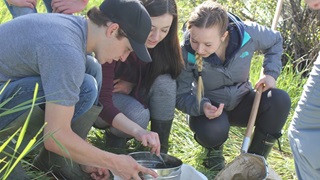A ‘living, working landscape’: Beaver Hills earns biosphere reserve status from UNESCO
Through sustainable land use, Alberta region balances need for both industry and biodiversity
Glen Lawrence’s great-great-grandfather arrived in the Edmonton area from the Scottish highlands in 1904.
Even then, as new Canadians arrived from across the globe, they felt the Beaver Hills was a region worth protecting.
“It’s such a beautiful area,” says Lawrence of the Beaver Hills Initiative, a 1,600-square-kilometer treasure about 20 minutes east of Alberta’s capital that includes boreal mixed-wood forests, wetlands, lakes and streams, and hummocky “knob-and-kettle” terrain.
“We had one of Canada’s first national parks here. The first federal bird sanctuary. The first federal forest reserve,” he adds. “People were working hard to conserve it 100 years ago. Somebody saw something then. We have a responsibility to carry that on, and keep that vision alive.”
Since 2002, the Beaver Hills Initiative has included representatives of four Alberta counties, the provincial and federal governments, industry, community groups, Indigenous organizations, environmental groups and academia—all working together on sustainable land use in the area.
And in March 2016, after years of hard work, the Beaver Hills Initiative was awarded biosphere reserve status by the United Nations Educational, Scientific and Cultural Organization (UNESCO)—the 17th such UNESCO biosphere in Canada.
“Some people think that a biosphere means you kick all the people out and leave it to the birds. That’s not it at all. The key to a biosphere is that it’s a living, working landscape,” says Lawrence, who chairs the Beaver Hills Initiative.
“You have those core protected areas that are set aside for all the other species that we share this planet with. And there’s also what we call the buffer area—the places where we live, work and play,” he adds. “The whole concept of a biosphere is that everything is interconnected, and how we live in this biosphere will determine the health of everyone in it.”
The Beaver Hills moraine includes Alberta’s Industrial Heartland region, and it also includes Elk Island National Park, Miquelon Lake Provincial Park, Cooking Lake-Blackfoot Provincial Recreation Area, the Ministik Lake Game Bird Sanctuary and the Strathcona Wilderness Centre.
In recent weeks, the Beaver Hills Biodiversity Trail was officially opened near the Strathcona Wilderness Centre, adding about 2.5 kilometers of walking and cross-country skiing trails to an existing 12-km network. The trail was sponsored in part through a $21,860 grant by Enbridge.
“We need industry, and we also need these wild spaces that have such ecological importance—not only biodiversity for wildlife species (the Beaver Hills contain more than 300 species of wildlife, birds and amphibians), but for the airshed and watershed,” says Lawrence.
“It’s not about picking sides. It’s not about ideology. We’re not anti-anything. It’s about working together and looking at the big holistic picture—because in the end, we all benefit.”
(TOP PHOTO: The Beaver Hills terrain, east of Edmonton, Alberta, includes boreal mixed-wood forests, wetlands, lakes and streams, and hummocky “knob-and-kettle” terrain.)










